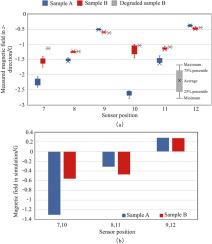Evaluation of lithium-ion batteries with different structures using magnetic field measurement for onboard battery identification
IF 16.4
引用次数: 0
Abstract
When Original Equipment Manufacturer (OEM) lithium-ion batteries (LIBs) in electric vehicles are substituted with lower-quality non-OEM batteries, instances of non-OEM battery-related fires and other incidents have been documented in a report. This underscores the need for a technology capable of authenticating (LIBs) to avert such incidents, especially in electric vehicle applications. Current identification technologies, such as barcodes and integrated circuit (IC) chips, are in place; however, these technologies can be susceptible to counterfeiting through duplication or replacement. Therefore, this study focused on the magnetic field around the LIBs themselves. In previous studies, current distribution analysis of LIBs using magnetic sensors has been conducted as a nondestructive failure determination method. However, this method has not yet been applied to battery identification. This study proposes the identification of individual LIBs through magnetic analysis. Magnetic fields of prismatic LIBs with varying internal structures were measured, and differences between the results were evaluated using theoretical equations and simulations. Consequently, distinct magnetic fields were measured on the short sides of the cell for each sample. This distribution was attributed to the difference in the shape of the current collector. Even when using two cells connected in series to simulate a LIB module, a similar trend was observed in the magnetic field distribution. Magnetic sensors were utilized to measure the magnetic field characteristics of different internal structures of LIBs and reproduce relative relationships in the simulations. These results suggest that individual LIBs can be distinguished by strategically positioning magnetic sensors. The proposed system could serve as fundamental technology for identifying individual battery modules.

基于磁场测量的不同结构锂离子电池板载电池识别评价
当电动汽车中的原始设备制造商(OEM)锂离子电池(lib)被质量较低的非OEM电池所取代时,非OEM电池相关的火灾和其他事件的实例已被记录在一份报告中。这强调了需要一种能够验证(lib)的技术来避免此类事件,特别是在电动汽车应用中。目前的识别技术,如条形码和集成电路(IC)芯片,已经到位;然而,这些技术很容易通过复制或替换而被伪造。因此,这项研究的重点是lib本身周围的磁场。在以往的研究中,利用磁传感器对lib的电流分布进行分析,作为一种非破坏性的失效判定方法。然而,这种方法尚未应用于电池识别。本研究提出了通过磁性分析鉴定单个lib的方法。测量了具有不同内部结构的棱镜LIBs的磁场,并利用理论方程和模拟方法评估了结果之间的差异。因此,在每个样品的细胞短边测量不同的磁场。这种分布归因于集流器形状的不同。甚至当使用串联连接的两个电池来模拟LIB模块时,在磁场分布中也观察到类似的趋势。利用磁传感器测量LIBs不同内部结构的磁场特性,并在模拟中再现其相互关系。这些结果表明,单个lib可以通过战略性地定位磁传感器来区分。该系统可以作为识别单个电池模块的基础技术。
本文章由计算机程序翻译,如有差异,请以英文原文为准。
求助全文
约1分钟内获得全文
求助全文

 求助内容:
求助内容: 应助结果提醒方式:
应助结果提醒方式:


